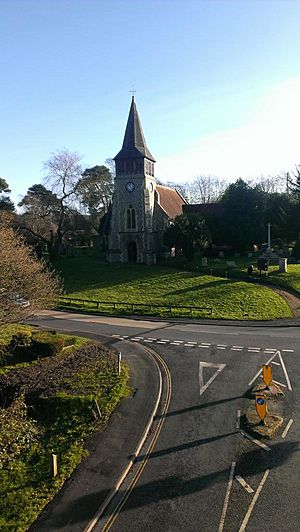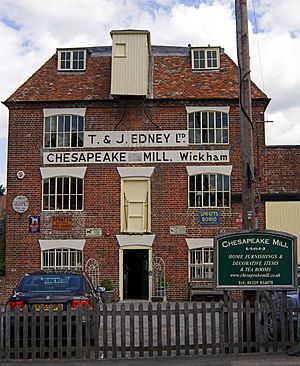Wickham, Hampshire facts for kids
Quick facts for kids Wickham |
|
|---|---|
 St Nicholas Church in Wickham |
|
| Area | 1.188 km2 (0.459 sq mi) |
| Population | 2,173 (2021 census) |
| • Density | 1,829/km2 (4,740/sq mi) |
| OS grid reference | SU572115 |
| Civil parish |
|
| District | |
| Shire county | |
| Region | |
| Country | England |
| Sovereign state | United Kingdom |
| Post town | FAREHAM |
| Postcode district | PO17 |
| Dialling code | 01329 |
| Police | Hampshire |
| Fire | Hampshire |
| Ambulance | South Central |
| EU Parliament | South East England |
| UK Parliament |
|
Wickham is a historic village in Hampshire, England. It is located about 3 miles north of Fareham. In 2021, around 2,173 people lived in Wickham. The village is known for its old market square, which has been used for trading for hundreds of years. This area is protected as a special "conservation area" because of its history.
Wickham was once an important crossing point over the River Meon. This was on a Roman road that connected major Roman towns like Chichester and Winchester. Another Roman route from Wickham likely went to Bitterne. Today, some local roads still follow the path of the old Roman road towards Chichester.
The village is also famous as the birthplace of William of Wykeham. He was a very important person who founded two famous schools: Winchester College and New College, Oxford. Wickham also had a station on the Meon Valley Railway. This railway line closed in 1955, but now it's a popular path for cycling and horse riding. Every year on May 20th, Wickham hosts a traditional gypsy horse fair in the village square.
Contents
Wickham's Long History
Early Settlements and Roman Times
The Romans built a settlement in Wickham because it was on an important road. They also found iron works northeast of the village. Many Roman items have been discovered in the area.
The first time Wickham was mentioned in writing was in a Royal Charter document from 826. This was during the time of the Saxons in Britain. Digs at the Manor House in the 1960s found evidence of Saxon homes and huts.
After the Norman Conquest
After the Normans took over England, King William gave the land of Wickham to Hugo de Port. The village was even mentioned in the Domesday Book in 1086.
The current Church of St Nicholas was built in 1126. In 1269, King Henry III allowed markets to be held in Wickham every Thursday. This is when the village started to look like it does today. Wickham also had a fair that brought people from all around. The Wickham Horse Fair still happens every year on May 20th.
Industry and Victorian Era
In the 1700s, Wickham had a busy industry for making leather (called "tanning"). In the 1700s and 1800s, there was also a brewing industry. Both needed fresh water, which came from the River Meon. By 1801, Wickham had 901 people, which was a large number for a village back then.
In 1820, the famous Chesapeake Mill was built. It was made using wood from an American ship called the USS Chesapeake. This ship was captured during the War of 1812. A brave naval officer, Sir Richard Grindall, who fought at the Battle of Trafalgar, is buried in Wickham churchyard.
In 1903, a railway line was built through Wickham. It connected Fareham to Alton. The railway stopped carrying passengers in 1955. Today, the old railway line is a walking path. You can still see parts of the original station platforms.
In 1978, Wickham became "twinned" with a French village called Villiers-Sur-Mer. This means they have a special friendship. Wickham Vineyard, where grapes are grown to make wine, opened in 1984.
Fun Events and Culture
Wickham Festival
North of Wickham, there's a big field where the amazing Wickham Festival takes place. This is a 4-day music event that wins awards! The first festival was held in 2006. Many different artists from around the world have played there.
After a short time away, the festival returned to Wickham in 2010. It has been held there ever since. Over the years, famous musicians like James Blunt and The Proclaimers have performed.
Taste of Wickham Food Festival
"Taste of Wickham" is a food festival held in the village's medieval square. It started in 2014. The festival offers local food, barbecues, and cooking shows. More than 4,000 people have come to enjoy the food and fun. The festival returned in 2015 with even more stalls and music.
Wickham Horse Fair
England's biggest and oldest horse fair happens in Wickham every year on May 20th. It is one of only two major horse-trading events in the country. This fair has been happening since 1269! People gather to trade horses, meet friends, and show off their animals. The fair includes parades where ponies are decorated with ribbons.
Shopping in Wickham

Wickham's village square has many places to visit. You can find bars, restaurants, shops, and hotels there. Bay Tree Walk is a nice area for shopping. The Chesapeake Mill is a very old water mill that has been turned into a place with many different shops.
Sports and Fun Activities
Wickham has a community centre where many activities take place. There is also a tennis club for those who enjoy playing. The village has a public skatepark. There is also a special astroturf pitch with lights for playing sports.
The Meon Valley Railway Line is now a long path for walking, cycling, and horse riding. It is about 17.5 kilometers (11 miles) long. This path follows part of the old railway line that closed in 1968.
Wickham and Knowle Parish
The area around Wickham is part of a "civil parish." Until 2022, it was called Wickham civil parish. Now it is known as Wickham and Knowle.
Wickham Common is an area of shared land a little south-east of the village. It has both grassy areas and woodlands. There is also a small group of houses called Wickham Common.
Important roads like the A32 and the A334 run through the parish.
Famous People from Wickham
- Arthur Churcher (1871–1951) was a British Army officer. He also became the Mayor of Windsor.
- Mary Donaldson, Baroness Donaldson of Lymington was the first woman to become the Lord Mayor of London.
- Amelia King worked at Frith Farm in Wickham during World War II. She was part of the Women's Land Army.
- Vice Admiral Thomas Revell Shivers (1751–1827) was a high-ranking naval officer.
See also
 In Spanish: Wickham (Hampshire) para niños
In Spanish: Wickham (Hampshire) para niños



